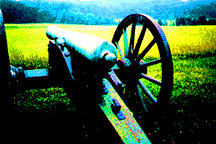

 Our
Civil War class followed the route of Lee's Antietam Campaign
in a series of four field trips which explored:
Our
Civil War class followed the route of Lee's Antietam Campaign
in a series of four field trips which explored:
Cedar Mountain is a small mountain near Culpeper, Virginia. The battle did not take place on the mountain but in the countryside nearby. Today the area is still rolling farmland, mostly privately owned.
The Battle of Cedar Mountain is not well known. It took place in August 1862 between The Seven Days' Battles (seven weeks earlier) and Second Bull Run, and was eclipsed in size and fame by those famous battles. Lee's victories defending Richmond in the Seven Days' Battles encouraged him to head northward. At Cedar Mountain, Stonewall Jackson's troops engaged General John Pope's army. After his victory here, Jackson moved to Gordonsville where he rejoined Lee and Longstreet. Pope moved north, planning to fight the Confederates near Centreville. The Confederates moved northward also and met their enemy on the fields where First Bull Run was fought a year earlier.
The Second Battle of Bull Run is also know as Second Manassas. Much of the land where it took place retains it's pastoral appearance because it has been preserved as Manassas Battlefield National Park. It is in Prince William County, Virginia.
The beauty of the area today belies the fact that three days of bloody combat brought down thousands of brave men - 16,000 Union casualties, 9200 Confederates. After Lee's victory here, he attacked Union forces again at nearby Ox Hill, but that battle was technically a draw. Lee then moved northward again, planning to take the war into Maryland and Pennsylvania. Lincoln removed Pope from command and reluctantly reinstated McClellan.
For more on the Second Battle of Bull Run, click here.

 South
Mountain is near Frederick, Maryland. Our tour began in Leesburg and
followed Lee's route across the Potomac through Frederick and into the mountains.
Much of the country we passed through is still rural and beautiful, although
the city of Frederick has grown into a sprawling suburb of Washington, DC.
South
Mountain is near Frederick, Maryland. Our tour began in Leesburg and
followed Lee's route across the Potomac through Frederick and into the mountains.
Much of the country we passed through is still rural and beautiful, although
the city of Frederick has grown into a sprawling suburb of Washington, DC.
September 1862: In the gaps of South Mountain, Lee's momentum slowed. A copy of his plans had fallen into Union hands, and he was barely able to hold the gaps long enough to allow Jackson to take Harper's Ferry.
Bolivar Heights is a ridge overlooking Harper's Ferry, West Virginia. Lee had split his army and sent part to approach Maryland through Harper's Ferry. A Southern victory here enabled troops here to approach Maryland from a second direction. They crossed the Potomac near Shepherdstown and proceeded toward the town of Sharpsburg near Antietam Creek.
Meanwhile, McClellan's army caught up with the rest of Lee's Army in the fields near Antietam. The result was the bloodiest day of the Civil War. The tired confederate troops who arrived from Harper's Ferry were not able to change the results of the battle - a defeat for Robert E. Lee, which was disastrous for the Confederacy because it ended the chance that England and France would support the south.
Antietam Battlefield has been preserved and like many key areas of the war, is beautiful and peaceful in spite of it's horrific history. A visitors' center and numerous markers are there to help the visitor to interpret this famous place.
For more pictures of the Antietam tour, click here.
 About
the author: Linda Walcroft has taken the entire nine-semester series
of Civil War classes under Dr. Charles Poland.
The classes were offered by Northern Virginia Community College, Annandale Campus.
About
the author: Linda Walcroft has taken the entire nine-semester series
of Civil War classes under Dr. Charles Poland.
The classes were offered by Northern Virginia Community College, Annandale Campus.
See Why I Study the Civil War.
|
Other photos taken by Linda Walcroft, Fall 2002 Return to top of Page | Maryland Civil War Trail, Antietam | South Mountain State Park |
Find books on Antietam